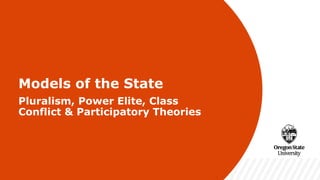
Models of the State.pptx
- 1. v Models of the State Pluralism, Power Elite, Class Conflict & Participatory Theories
- 2. Micro, Meso and Macro Theory Micro-level Theories • At the micro scale, social scientists scrutinize the most minute facets of interaction. Analyses at this level might delve into individual interactions between couples or friends. Alternatively, a social scientist might explore how a person's self-perception is shaped by their social context. Meso-level Theories • When delving into groups, social scientists operate at the meso level. Researchers at this level might investigate variations in workplace behavior norms across professions or examine the organizational structure of environmental clubs, among other examples. Macro-level Theories • At the macro level, social scientists investigate overarching social structures and institutions. Research at this scale explores large-scale patterns, with a growing focus on the processes and impacts of globalization in recent years. An example of a macro-level study could be an examination of the interrelationships between nations in the context of globalization.
- 3. Classic Macro Theories of the Policy Process Units of Analysis (Power and Policy Drivers) • Pluralism: Interest Groups/Groups (Robert Dahl, “Who Governs”) • Power Elite: Public and Private Organizational Elites (C. Wright Mills, “Power Elite”) • Class Conflict: Socioeconomic Classes (Ralph Miliband, “Divided Societies”) • Participatory: Individual Voters (normative preference)
- 4. Pluralism Theory Unit of Analysis: GROUPS, whose preferences (motives, grievances, etc.) and values (accepted norms, personal commitments) must be ultimately referred. Propositions: • Individuals take actions through groups compatible with their preferences/values. • Groups represent an aggregate of individuals. • Group cooperation and compromise leads to societal consensus through: Communication of preferences to others, formation of public opinion, responsive actions of group elites. • Public policy is a result of interest group bargaining and compromise. • The state is a negotiator/referee of disputes. • The state mirrors public and group preferences-it confirms to public opinion. • Interest groups compete/cooperate-they do not overlap. • Group competition compromise will lead to virtual self-regulation of society-counter– balance effect. • Toleration of diverse ideas and groups.
- 5. Power Elite Theory Unit of Analysis: ‘PUBLIC’ and PRIVATE ORGANIZATIONAL ELITES – the organizational base and activities of elites are the focus of analysis. Propositions: • The state is made up of a variety of organizations and structures that have different resources for domination of society and the state (unlike the class-conflict model which focuses upon capital ownership). In order words, some groups win in the policy-making process. • The state is first and foremost the dominant organization in society- a monopoly of power. • Organizations are tools or instruments of elites, not collections of individuals (masses). • Major organizational goal = survival of the organization. So, monopolies/mergers emerge over competition. • Elite conflicts are managed by elite negotiations and legal orders. Some elites do not survive if the organizational basis is not strong. • Individuals (masses) must be induced or coerced into the appropriate beliefs/behavior that will lead to conformity with elite rules. • New organizations are allowed to emerge as long as they do not effectively challenge the status quo. Token opposition is fine (and may be encouraged to increase legitimate authority of the state- “free to choose” and “freedom of opinion/organization”). • Manipulation of masses by elites. Elites are highly educated and knowledgeable; masses are apathetic and less educated.
- 6. Class Conflict Theory Unit of Analysis: SOCIO-ECONOMIC CLASSES exiting in a particular stage of development. The productive base of society (e.g., capitalistic, feudalistic, etc.) leads to certain class dominating the state through its economic resources (property?). Propositions: • Individual actions and organizational interests must be understood in the context of class relations within a certain ‘mode of production’ (e.g., manufacturing, service, etc.). • The stage of economic development provides the conditions under which certain types of organizations emerge and flourish while others die or do not even appear (e.g., you don’t see Green Peace in Ethiopia). • Conflict theories focuses on three aspects of society as important (capitalism example): (a) Individuals must sell their labor as a commodity to others, who own the means of production; (b) The dominant economic organization (e.g., business) depend upon capital accumulation (profile, investment); and (c) The economy is dominated by privately controlled production for commodity markets. • The ruling classes (capital) rule over the boundaries of the state- the state’s main function is to protect the capital class interests in general. Certain individual capitalists and industries are allowed to go under, but not the whole class. • No such thing as the ‘public interest’ exists; only ‘class interest’ do-therefore different classes have different interests-class conflict. Capital accumulation vs. social welfare needs.
- 7. Participatory Model Unit of Analysis: INDIVIDUALS, not groups, classes, elites, etc. Propositions: • Individuals (voters) participate in political life spontaneously; they are not elite-directed. • The overwhelming majority of eligible voters participate in the policy process. • Individuals are informed and knowledgeable about political/policy affairs; they are not manipulated by elites (bounded rationality?) • There are fair, honest, and egalitarian means for citizens to express their political desires - e.g., elections, town hall meetings, public meetings, etc. • Policy is the product of majority preferences, not group, class, or elite preferences.
- 8. Conclusion